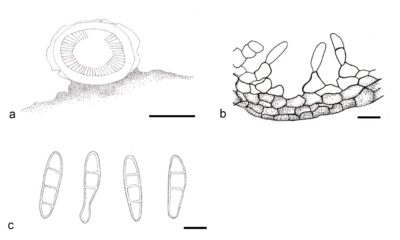Fungalpedia – Note 273, Camporesia
Camporesia W.J. Li & K.D. Hyde
Citation when using this entry: Perera et al. 2024 (in prep) – Fungalpedia, genera described in 2016.
Index Fungorum, Facesoffungi, MycoBank, GenBank, Fig. 1
Classification: Xylariaceae, Xylariales, Xylariomycetidae, Sordariomycetes, Pezizomycotina, Ascomycota, Fungi
Li et al. (2016) introduced this monotypic genus to accommodate coelomycetous taxon, Camporesia sambuci based on the analysis of LSU, ITS, rpb2, and tub2 markers. Camporesia is characterized by globose, superficial to subepidermal, separate, unilocular, ostiolate, and thick-walled pycnidia. The pycnidial wall is composed of cells of the texura angularis, with inner hyaline layers gradually merging with outer dark brown layers. Conidiophores are short, unbranched, hyaline, and emerge from the innermost layer of the wall cells. Conidiogenous cells are hyaline, phialidic, ampuliform, and smooth-walled, with periclinal wall thickening at the tip. Camporesia species have pale brown fusiform conidia that are rounded at both ends, 2–3-septate and smooth-walled (Li et al. 2016). However, the sexual morph remains undetermined. Camporesia sambuci is saprobic on dead plant stems (Li et al. 2016). The genus is distinct from libertella-like species in that it contains pale brown fusiform conidia (Li et al. 2016).
Type species: Camporesia sambuci W.J. Li & K.D. Hyde
Other accepted species: This genus is monotypic
Figure 1 – Camporesia sambuci (MFLU 15–3905, holotype). a Vertical section of conidioma. b Conidiophores, conidiogenous cells and developing conidia c Conidia. Scale bars: a = 100 μm, b, c = 5 μm. Redrawn from Li et al. (2016).
Reference
Entry by
Rekhani Hansika Perera, Center of Excellence in Fungal Research, Mae Fah Luang University, Chiang Rai, 57100, Thailand.
(Edited by Kevin D. Hyde, Samaneh Chaharmiri-Dokhaharani, & Achala R. Rathnayaka)
Published online 28 May 2024
